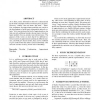Free Online Productivity Tools
i2Speak
i2Symbol
i2OCR
iTex2Img
iWeb2Print
iWeb2Shot
i2Type
iPdf2Split
iPdf2Merge
i2Bopomofo
i2Arabic
i2Style
i2Image
i2PDF
iLatex2Rtf
Sci2ools
ISMIR
2005
Springer
2005
Springer
Classifier Combination for Capturing Musical Variation
At its heart, music information retrieval is characterized by the need to find the similarity between pieces of music. However, “similar” does not mean “the same”. Therefore, techniques for approximate matching are crucial to the development of good music information retrieval systems. Yet as one increases the level of approximation, one finds not only additional similar, relevant music, but also a larger number of not-as-similar, non-relevant music. The purpose of this work is to show that if two different retrieval systems do approximate matching in different manners, and both give decent results, they can be combined to give results better than either system individually. One need not sacrifice accuracy for the sake of flexibility.
Approximate Matching | Information Retrieval | ISMIR 2005 | Music Information Retrieval | Retrieval Systems |
| Added | 27 Jun 2010 |
| Updated | 27 Jun 2010 |
| Type | Conference |
| Year | 2005 |
| Where | ISMIR |
| Authors | Jeremy Pickens |
Comments (0)

